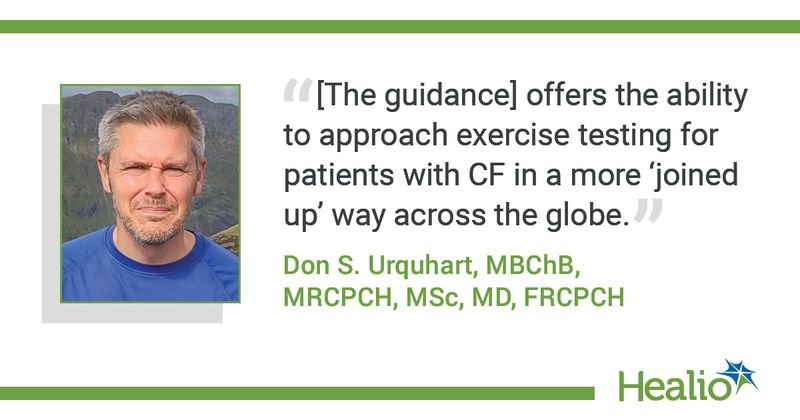Q&A: Establishing global standard for exercise testing in patients with cystic fibrosis
Key takeaways:
- A recent document establishes standard operating procedures for exercise testing in patients with cystic fibrosis across the globe.
- It outlines tests that can be used in lower income countries.
For patients with cystic fibrosis, exercise helps with disease management, and exercise tests allow clinicians to assess lung health, muscle strength and treatment response, according to a press release from University of Portsmouth.
Prior to a recent multidisciplinary expert consensus document published in European Respiratory Reviews, standard global operating procedures for these tests in patients with CF did not exist.

The lack of clinician guidance and inconsistencies in testing inspired the creation of this document discussing procedures for exercise testing. Notably, experts from America, the U.K., France, Switzerland, Germany and Australia, among others, came together to craft this document for use across countries.
To learn more about exercise testing in patients with CF, the international guidance document and hopes for the guidance, Healio spoke with Don S. Urquhart, MBChB, MRCPCH, MSc, MD, FRCPCH, deputy coordinator of the European Cystic Fibrosis Society and consultant in pediatric respiratory and sleep medicine at The University of Edinburgh in Scotland, and Zoe L. Saynor, MSc, PhD, associate professor in clinical exercise physiology at University of Portsmouth in England.
Healio: Why are exercise tests important to carry out in patients with CF?
Urquhart: Exercise tests integrate lung health, muscle function and physical conditioning to give a good overview of an individual’s health. One analogy I like to use is that spirometry tells us how much air is in the lungs and how fast it comes out (eg, how much gas is in the tank), whilst an exercise test tells us about performance and efficiency of the lungs, cardiovascular and muscle systems (eg, what the car is like to drive). Exercise information is becoming increasingly important in CF because it:
- improves well-being as a result of highly effective modulator therapy (people with CF doing more exercise);
- increases exercise promotion due to potential weight gain effects of highly effective modulator therapy; and
- stabilizes lung health, meaning that newer markers of change are being looked at and exercise testing may have a role here.
Further, it is known that exercise capacity is a predictor of decline in CF.
Healio: Prior to this clinical practice guidance, why have some patients been unable to access these tests?
Urquhart: The guidance covers a number of tests. Some tests (eg, cardiopulmonary exercise tests) have been harder to access for reasons such as lack of equipment or lack of trained personnel. This has led to “field tests” (portable tests) being performed but with a lack of consistency in test choice, and in some cases, in test conduct.
Healio: Can you briefly explain what is featured in the guidance? What are the main takeaways?
Urquhart: The document recommends cardiopulmonary exercise testing as the “gold standard” test. The document also recommends some other tests that can be done if there is a lack of resource or expertise (eg, maximum workload testing without gas exchange). The document also reviews the evidence for and test conduct for a range of “field tests.”
The main takeaway is to standardize the way tests are done, and a supplementary file containing standardized operating procedures (SOPs) for each test is provided as part of the paper. An example of this would be if you decide to do a maximum workload test on a bike in Edinburgh, it should be done in the same way as in Brisbane.
Healio: In the press release, it was noted that several hospitals in the U.K. have started using the multidisciplinary expert consensus document. What were the initial reactions of clinicians and patients?

Saynor: A number of U.K. clinics have already approached us for the instructions and operating procedures and purchased exercise bikes to implement new exercise tests in line with this. Physiotherapists have also contacted us to say this is long-awaited guidance.
Healio: Do you expect clinicians and patients in the U.S. to react similarly to those in the U.K.?
Urquhart: I am not sure; however, the expert consensus document is international, and representatives from the U.S., Australia and Europe were included in the writing group. There is a symposium on exercise at this year’s North American CF Conference, so the interest is clearly there. Although the guidance is not earth-shattering, it offers the ability to approach exercise testing for patients with CF in a more “joined up” way across the globe.
Healio: How will the clinical practice guidance aid in advancing cystic fibrosis treatment, especially for low- and middle-income countries?
Urquhart: I think the biggest aid of this guidance is providing confidence and standard procedures for undertaking exercise tests. There is a toolkit of tests here that are able to be used in less well-resourced health care systems than the National Health Service. Having SOPs allows interested health care professionals to build experience with a chosen test to aid longitudinal patient evaluation.
References:
- Saynor ZL, et al. Eur Respir Rev. 2023;doi:10.1183/16000617.0029-2023.
- New international guidelines will improve cystic fibrosis treatment. https://www.port.ac.uk/news-events-and-blogs/news/new-international-guidelines-will-improve-cystic-fibrosis-treatment. Published Aug. 9, 2023. Accessed Aug. 11, 2023.
